The MGA With An Attitude
FORD "Type-9" 5-SPEED GEARBOX for the MGA - GT-402A
Bellhousing and Spigot Bushing Modification
It has been brought to my attention that there are some variations in the North American T9 gearbox (Mercury Merkur XR4Ti in the USA) that can give problems with the Hi Gear installation kit. The NA unit has these numbers on the housing: FORD 62040, 839T-7211-CB (plus a serial number).
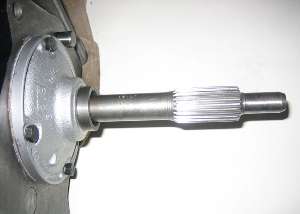 Ford Sierra gearbox
Ford Sierra gearbox
|
|
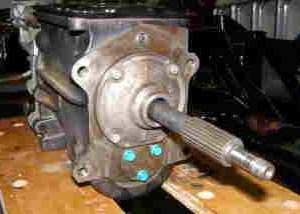
Mercury Merkur gearbox
|
Where the UK version of the gearbox has a flat front face with a flush hole plug for the layshaft, the NA version has a protruding bolted cover plate. The flat face unit originally has small needle rollers on the layshaft (limit about 140 BHP). The unit with the bolted plate on front originally has heavy duty rollers for the layshaft (good for higher output engines). Not to be mislead, it is possible to modify the light duty unit to install the heavy duty layshaft without adding the front plate. It is also possible to add the front plate only to fool you into thinking the unit is heavy duty when it is not.
Additionally the input shaft length 195 mm is about 20 mm (3/4") longer on the Merkur box. The European Granada box is similar to the Merkur unit. For the NA unit the back surface of the adapter bellhousing will need to be machined to clear the bolted plate. The input shaft may need to be shortened, including grinding of the splines, to fit the High Gear spigot adapter. Alternately an adapter spigot bushing can be used in the MG crankshaft without using the High Gear spigot adapter.
At 06:02 PM 11/2/2008 -0800, Peter Tilbury wrote:
"Hi-Gear had suggested it was necessary to dismantle the gearbox, remove the input shaft, and cut it shorter by about ¾”, and grind the splines back. I found that I could remove the Hi-Gear supplied spigot bush, and replace it with a new bush with original OD to fit inside the crankshaft, and new ID to suit the Merkur input shaft diameter (15mm). This gave me the 18 mm clearance required for the longer input shaft."
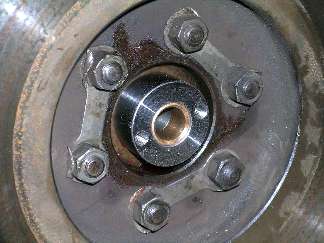
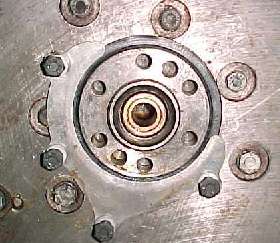
Photo above left shows the High Gear spigot adapter for the MGA and early MGB 3-main bearing crankshaft as it is used with the Sierra gearbox. For the Merkur gearbox with longer input shaft the spigot adapter is not needed. Instead you can use an adapter bushing in the crankshaft to reduce the spigot ID from 5/8-in (0.625") to 15-mm (0.591"). Photo above right shows the MGB 5-main bearing crankshaft with MGA engine rear plate modified to accept the MGB rear seal. Notice the adapter spigot bushing with one bushing inside of another. The later MGB crankshaft has a larger bore for the spigot bushing.
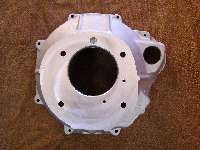
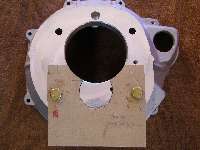
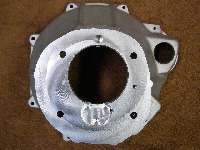
Rear of bell housing (flat) – Template for machining - Machined bell housing
Peter Tilbury continued:
"I also machined the back of the Hi-Gear bell housing to clear the plate and bolt heads, and shortened one of the bolts that mount the clutch lever from 30mm to 22mm (as the mounting hole is partially removed by the machining. The supplied gasket for the bell housing also had to be replaced with a new gasket to clear the front plate."
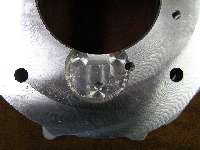
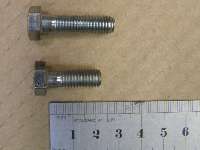
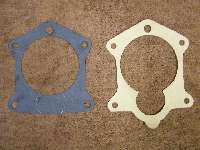
Machining shortens mounting hole - Shortened bolt - Modified gasket options
Barney's notes: It strikes me that the machining could be a bit simpler if the pocket was enlarged slightly to be rectangular. I might also recommend installing Heli-Coil thread inserts for the tapped holes (anywhere that a bolt is installed in a tapped aluminum part when it might be reassembled more than once). The paper gasket is not a seal but only a parting agent between the iron gearbox case and the aluminum bellhousing. As such it can be sufficient to cut away the part of the supplied gasket that interferes with the small end plate, not needing to make a new gasket.
Apparently, there is another version of the Merkur gearbox that has the longer shaft, but does not have the additional front plate. That one could use the simpler spigot bushing and would not require machining of the bellhousing.
Addendum October 2009:
Here is another idea for making the long input shaft conform to the shorter shaft dimensions.
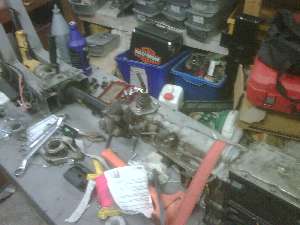
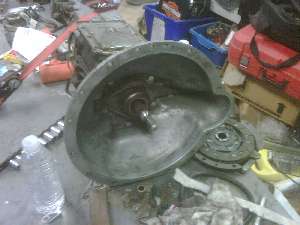
On 10/8/2009, Bruce Smith in Bremerton, WA, USA wrote:
"After completing most of the conversion to a five speed for my Spitfire, I discovered your site talking about the different input shaft lengths and about the type 9 gearbox out of a Merkur was to long for the conversion.
I didn't want to disassemble a perfectly good gearbox and try to find some one to turn the shaft, so I got to thinking. I had the front short section of the Merkur drive shaft which has a threaded hole in the end. I found a bolt the would thread into this hole and cut the head off. Then I took a power drill and tightened the chuck onto this bolt. When I turn the drill on, it powered the gearbox via the output shaft.
I then took a grinding stone on a die grinder and proceeded to grind about 3/4 of an inch off the spline. When I got within about .030 if the shaft size, I switched to a course emery cloth. When I got to within .005 of the size I went to 180 grit emery cloth. It worked perfect. I did spend about two hours doing it, but am very happy with the result. I then cut the very end of the shaft off to proper length and put a chamfer on the shoulder. I looks almost factory. Just take your time and don't get the shaft too hot, or you could take the hardening out of the shaft".
Addendum December 10, 2014:
This one popped up on Albany Craig List in early December 2014. For as long as the ling may last, see here: http://albany.craigslist.org/pts/4793593460.html
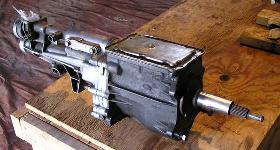
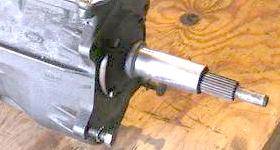
I tried to blow it up 2X and lighten the image some. Near as I can tell is has the flat front face, but it also has a throw out bearing guide that will not work with the MG release arm and release bearing. The tubular guide might be cut off to solve that issue, but I don't know the dimensions of the input shaft. Let the buyer beware, there are apparently more derivatives of this gearbox than we may know.
|